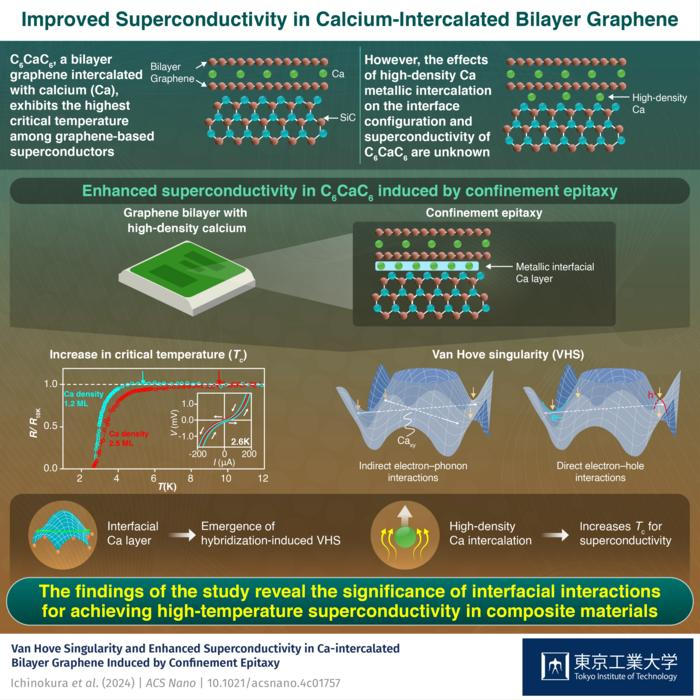In a recent study, a group of Japanese scientists from the Tokyo Institute of Technology examined the effects of introducing high-density Ca experimentally to C6CaC6 to increase superconductivity in graphene. The study was published online in ACS Nano.
 The findings of the study reveal the significance of interfacial interactions for achieving high-temperature superconductivity in composite materials. Image Credit: Tokyo Tech
The findings of the study reveal the significance of interfacial interactions for achieving high-temperature superconductivity in composite materials. Image Credit: Tokyo Tech
Superconductors are substances that, when cooled below a specific critical temperature, have zero resistance to electrical conductivity. Magnetic resonance imaging, particle accelerators, electric power, and quantum computing are just a few of the domains in which they find use.
Nevertheless, the requirement for exceptionally low temperatures prevents their widespread use. Graphene-based materials could benefit superconductors because of their special qualities, which include optical transparency, mechanical strength, and flexibility.
One layer of carbon (C) atoms arranged in a two-dimensional honeycomb structure is known as graphene. The material with the highest critical temperature is the graphene-calcium (Ca) compound or C6CaC6. In this compound, a process known as intercalation adds a layer of calcium between two graphene layers. Although this material already has high critical temperatures, some research has indicated that adding high-density Ca can raise critical temperatures and, consequently, superconductivity.
On a silicon carbide (SiC) substrate, two graphene layers are grown, and then Ca atoms are added, causing Ca to intercalate between the layers and forming C6CaC6. It has been anticipated that intercalation with high-density Ca may cause changes in the C6CaC6 critical temperature. In particular, confinement epitaxy—a phenomenon where a metallic layer forms at the interface between SiC and the bottom graphene layer—may result from it. This layer has the potential to greatly affect the top graphene layer's electronic characteristics, such as causing van Hove singularity (VHS), which could increase C6CaC6's superconductivity. There is currently insufficient experimental support for this phenomenon.
The study was carried out under the direction of Assistant Professor Satoru Ichinokura from the Tokyo Institute of Technology's Department of Physics.
We have experimentally revealed that the introduction of high-density Ca induces significant intercalation at the interface leading to the confinement epitaxy of a Ca layer beneath C6CaC6, which gives rise to VHS and enhances its superconductivity.
Satoru Ichinokura, Assistant Professor, Department of Physics, Tokyo Institute of Technology
The scientists synthesized various C6CaC6 samples with different Ca densities and examined their electrical characteristics. The findings demonstrated that VHS emerges due to the interfacial metallic layer that forms at high Ca densities between SiC and the bottom graphene layer. According to the researchers, the formation of the interfacial Ca layer raises the critical temperature through the VHS. The researchers compared the properties of C6CaC6 structures with and without this layer.
They also discovered that VHS raises critical temperatures in two ways. First, there is an indirective attractive interaction between electrons and vibration-related particles called phonons, and second, there is a direct attractive interaction between electrons and holes, which are the empty spaces left by electrons in motion. These results imply that adding high-density Ca can achieve superconductivity at higher temperatures, which may increase the range of applications for C6CaC6.
The graphene-calcium compound, being a low-dimensional material composed of common elements, will contribute to the integration and popularization of quantum computers. With quantum computing, large-scale and high-speed computations of complex systems will be possible, enabling the optimization of energy systems towards carbon neutrality and dramatically improving the efficiency of catalyst development and drug discovery through direct simulation of atomic and molecular reactions.
Satoru Ichinokura, Assistant Professor, Department of Physics, Tokyo Institute of Technology
Overall, this study’s experimental results may result in C6CaC6 superconductors with improved characteristics and broad applications in critical fields.
Journal Reference:
Ichinokura, S., et al. (2024) Van Hove Singularity and Enhanced Superconductivity in Ca-Intercalated Bilayer Graphene Induced by Confinement Epitaxy. ACS Nano. doi.org/10.1021/acsnano.4c01757.